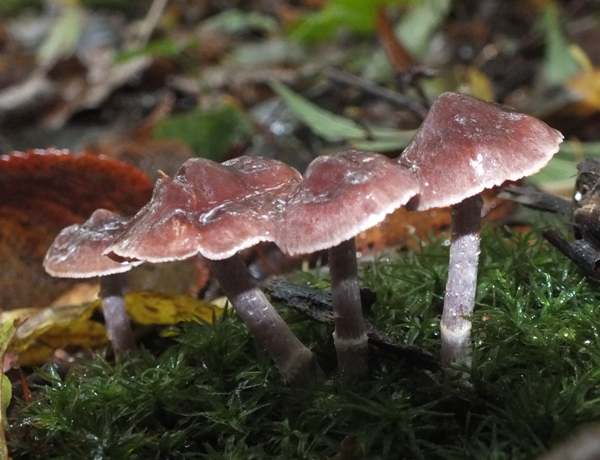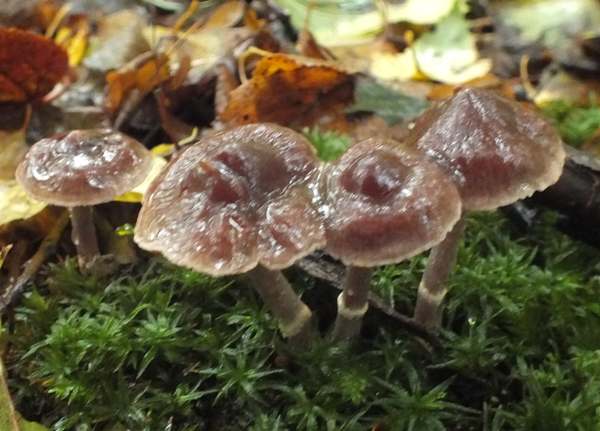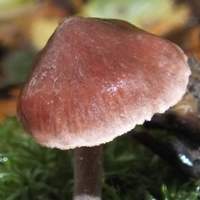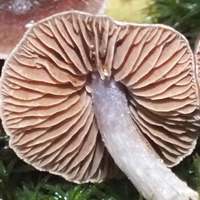Trees Birds Mammals Fish Amphibians Reptiles
Wild Algarve
Bookshop
Cortinarius decipiens (Pers.) Fr. - Sepia Webcap
Phylum: Basidiomycota - Class: Agaricomycetes - Order: Agaricales - Family: Cortinariaceae
Distribution - Taxonomic History - Etymology - Toxicity - Identification - Reference Sources

In the generally difficult Cortinarius group of fungi Cortinarius decipiens is not one of the easiest of species to identify from macroscopic characters alone; spore size and ornamentation need to be studied, and you really must find several specimens at different stages in their development. For example a lilaceous flush on the upper stem region is usually visible only while fruitbodies are young. Cap colour are is also quite variable and can change considerably as the fruitbody matures.

Two varieties of this species, var. decipiens and var. atrocoeruleus, are recognized by some authorities. The description below is of the type variety Cortinarius decipiens var. decipiens. A very rare (in Britain and Ireland, at least) variety is also found in dry deciduous woodland and has been given the scientific name Cortinarius decipiens var. atrocoeruleus; its spores are slightly smaller and its cap is much darker and is not (or is only very slightly) umbonate.
A similar webcap, also recorded at Cortinarius decipiens, is found in North America under conifers; it may be a different species, however, since the European form occurs with deciduous broadleaf trees.
Distribution
Cortinarius decipiens var. decipiens is uncommon but not rare in Britain and Ireland and is recorded from many parts of mainland Europe.
Taxonomic history
In his Synopsis Methodicae Fungorum of 1801, Christiaan Hendrik Persoon described this webcap mushroom and gave it the name Agaricus decipiens. (In the early years of fungal taxonomy most of the gilled mushrooms were included initially in the genus Agaricus!)
It was the great Swedish mycologist Elias Magnus Fries who, in 1838, transferred the Sepia Webcap to the genus Cortinarius, thereby creating its currently accepted scientific name Cortinarius decipiens .
Synonyms of Cortinarius decipiens include Agaricus decipiens Pers.
The vast genus Cortinarius is subdivided by many authorities into subgenera, and the Sepia Webcap belongs to the subgenus Telamonia.
Etymology
The generic name Cortinarius is a reference to the partial veil or cortina (meaning a curtain) that covers the gills when caps are immature. In the genus Cortinarius most species produce partial veils in the form of a fine web of radial fibres connecting the stem to the rim of the cap.
Just as it sounds, the specific epithet decipiens refers to the deceptively inconsistent appearance of this little webcap mushroom, which has been shown to be both genetically and morphologically very variable.
Toxicity
This mushroom is recorded in many field guides as 'suspect'. Because several of the webcaps are known to be deadly poisonous (and some research even suggests that all Cortinarius species may contain at least small amounts of the toxins concerned), the Sepia Webcap should in our opinion never be gathered for eating.
Identification guide
 |
Cap
Young caps of Cortinarius decipiens are sharply conical, becoming broadly convex with a distinct umbo and reaching 2 to 4.5cm in diameter. The cap surface is various shades of vinaceous buff with a pale marginal region and much darker towards the centre; shiny, covered in fine radial fibrils. |
 |
Gills
Adnate, moderately crowded; at first greyish ochraceous with a tawny tint, maturing reddish cinnamon.
Stem
The fibrous pale yellowish grey stem is covered in longitudinal white fibrils; in young fruitbodies there is a slight violaceous flush towards the stem apex; an indistinct white ring zone is left by the cortina (the partial veil), often with other white cottony velar remains adhering to the stem below the ring zone; 2-5mm in diameter and 3-7cm long. |
| |
Spores
Broadly ellipsoidal ovoid; minutely to moderately verrucose (with a roughened surface), 8,5-10 x 5-6.5µm; inamyloid.
Spore print
Rust-brown. |
Odour/taste |
Odour faint, of radish. Taste reported to be insignificant. (It is unwise to taste any Cortinarius species, as several of them are deadly poisonous.) |
Habitat & Ecological role |
Mycorrhizal, in damp mossy broadleaf woodland, often with birches and willows. |
Season |
July to November in Britain and Ireland. |
Similar Species |
Cortinarius hemitrichus, the Frosty Webcap, is similar in appearance. |
Reference Sources
Fascinated by Fungi, 2nd Edition, Pat O'Reilly 2016, reprinted by Coch-y-bonddu Books in 2022.
Funga Nordica, Henning Knudsen and Jan Vesterholt, 2008.
British Mycological Society, English Names for Fungi
Dictionary of the Fungi; Paul M. Kirk, Paul F. Cannon, David W. Minter and J. A. Stalpers; CABI, 2008
Taxonomic history and synonym information on these pages is drawn from many sources but in particular from the British Mycological Society's GB Checklist of Fungi.
Top of page...
Fascinated by Fungi. Back by popular demand, Pat O'Reilly's best-selling 450-page hardback book is available now. The latest second edition was republished with a sparkling new cover design in September 2022 by Coch-y-Bonddu Books. Full details and copies are available from the publisher's online bookshop...